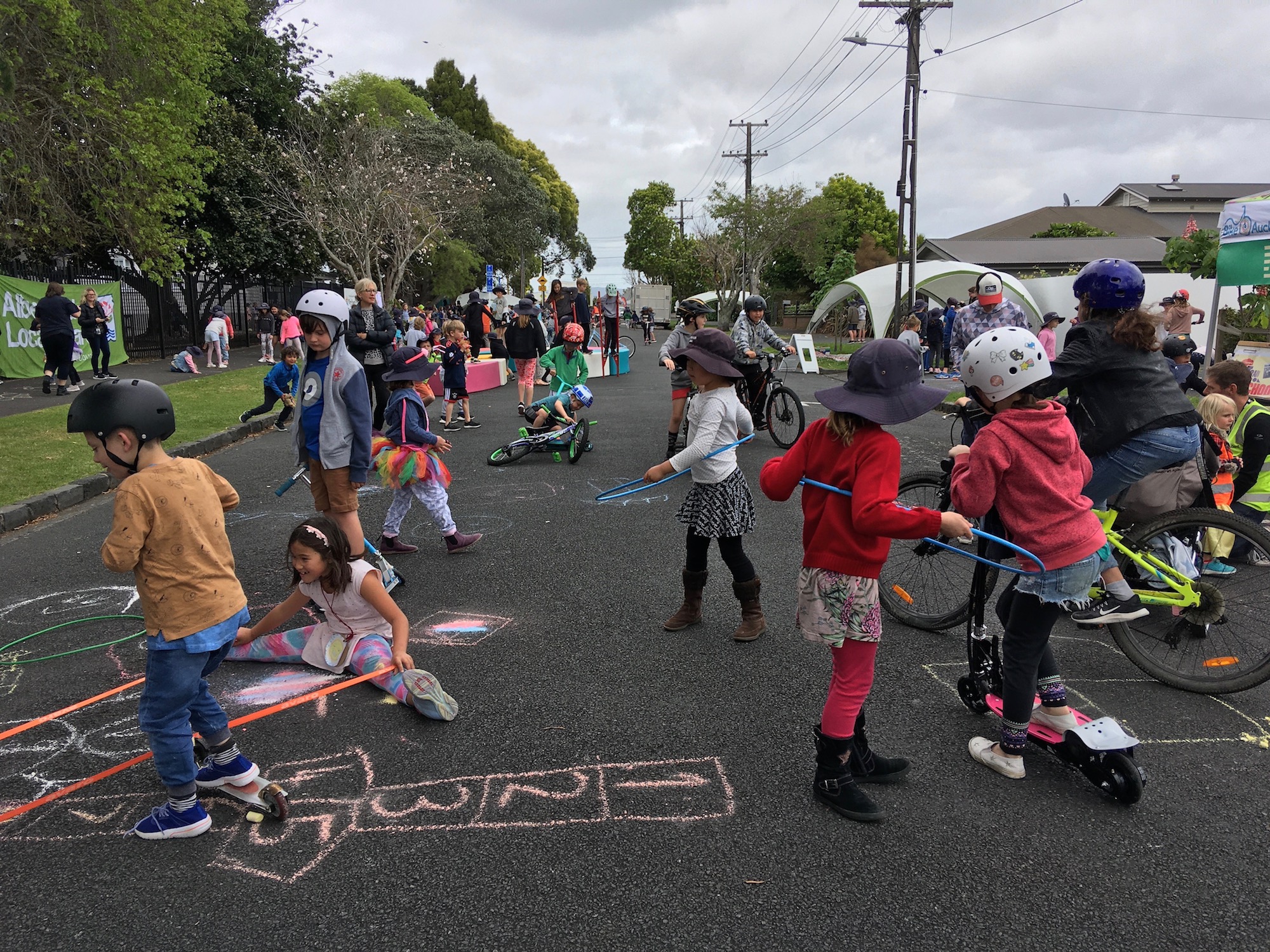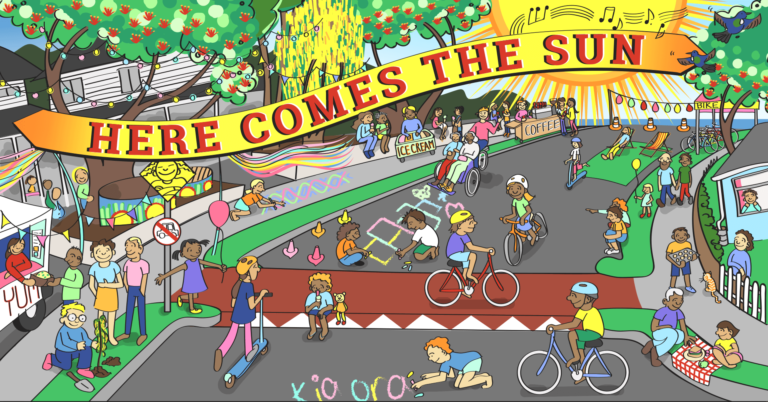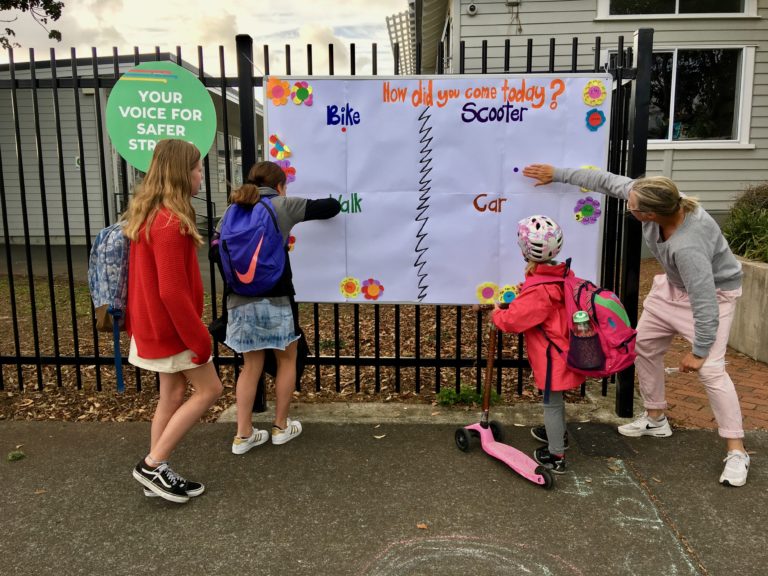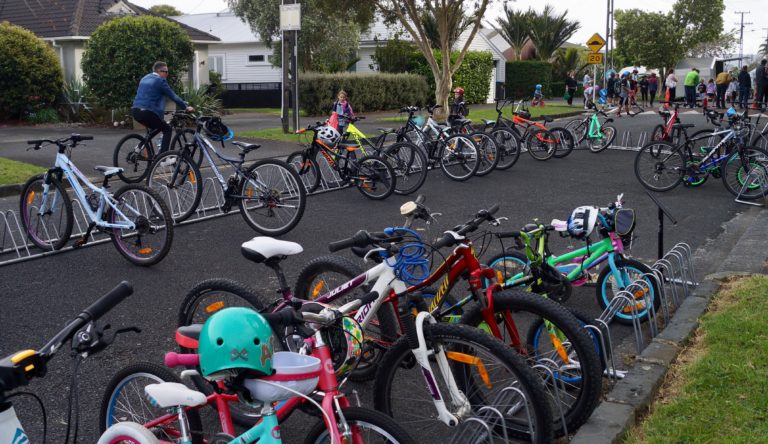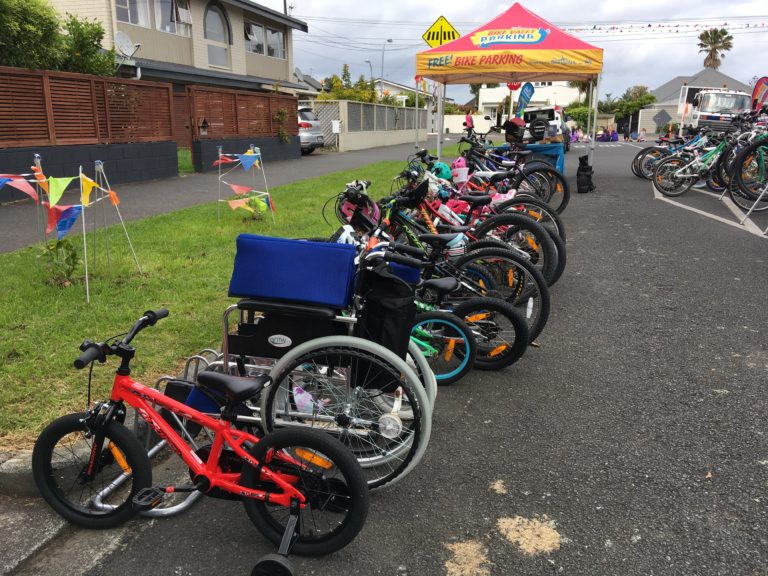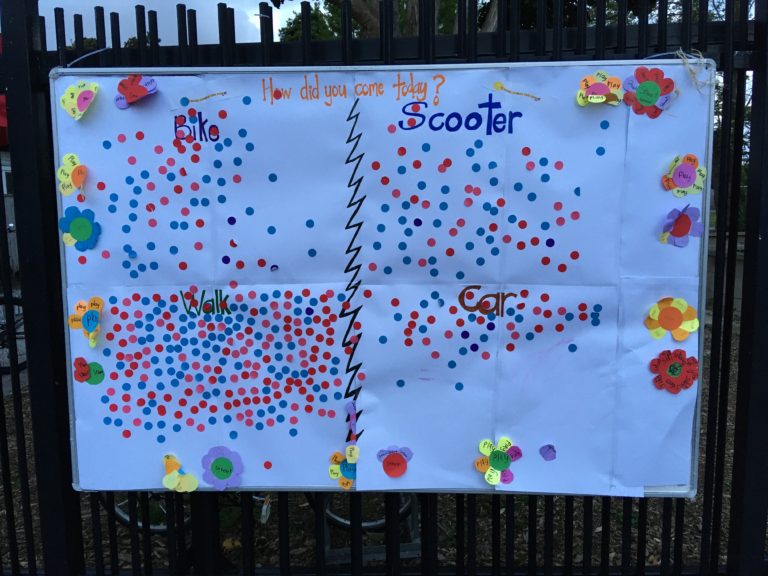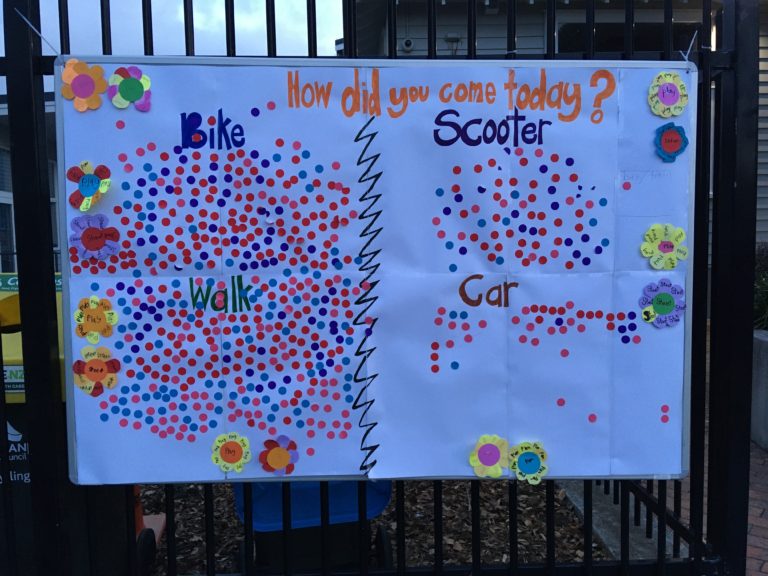On the first Friday in November, the street outside Point Chevalier School was closed to traffic and opened for fun, all day long, from 8am to 8pm.
The street became a children’s realm: free-range space to play, learn, bike, scoot, create, and discover. Kids from other local schools, kindergartens, and preschools joined in. And, as afternoon turned into evening, children and their families were joined by hundreds of neighbours for a street party and al fresco dinner.
Called ‘Here Comes the Sun’, it may have been a New Zealand first in combining the idea of a traffic-free school play street with a neighbourhood party. And it offers a model for future community events, large and small, that rethink how we use our streets.
So, as part of the small group of teachers, neighbours and friends who organised the event, it feels helpful to share some of what we learned.
First, a bit of background: why here, why now, why this?
Te Ra Road is a quiet side street off Pt Chevalier Road, home to a couple of dozen residences… plus the local primary school. Which means that twice a day, Mondays to Fridays during term time, it’s not a quiet street at all: cars squeeze into the little street as parents angle for a space to drop off and collect their children.
And while Pt Chev hasn’t yet merited a ‘chaos at the school gate’ headline (like this, this, or this), it still sees its fair share of double-parking, parents blocking driveways and driving on the footpath, and other dodgy manoeuvres that put children at risk and annoy the residents.
The school, which is home to the exemplary Bike Train, has one of the higher proportions in the city of kids who walk, bike, scoot, or get dropped off at a distance and walk the rest of the way. But even though only a third of children arrive by car, the large vehicles outweigh the little kids, as well as being a bugbear for neighbours.
We wanted to talk about different ways Te Ra Road could be. And more than just talking about it, we wanted to give people a chance to feel how different it could be.
We were inspired by neighbourhood street parties in other places we’d lived, and also by two international movements that are redefining streets around children’s fun and safety.
- Play streets close local streets to traffic to give kids space to play. The Playing Out movement was started ten years ago by a mum who wanted her children to be able to freely play outside, and councils like Hackney Council have been making it easier for schools and communities to regularly take over street space so children can play.
- School streets are an equally simple and appealing idea: keep traffic away from the school gate (except bikes!) at the beginning and end of the school day. The result: less congestion, a safer context for kids to walk or bike to school, and better air quality around the school as well.
- And, knowing Auckland Transport was working on a pilot scheme for Safe School Streets, we saw a chance to come at it from a slightly different angle, to help broaden the options.
Our journey from inspiration to delivery took about six months, and a LOT of hours. Here are ten things we learned along the way.
1. Start with a vision
We wanted a street party for the school community and nearby neighbours, which incorporated vibes from school streets and play streets. It would take place at the beginning of Term 4, just after Daylight Saving kicked in.
The name “Here Comes the Sun” was a nod to the street itself (Te Rã Road) and to the arrival summer – which was a bit of a gamble, in retrospect, but luckily the weather played along! And we decided to ‘go big or go home’: a full-day event, incorporating the whole school day and going all the way through to dinnertime. We reckoned food trucks on a Friday evening would be a natural attractor for parents and neighbours alike.
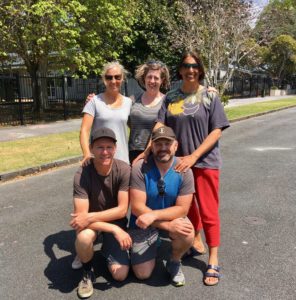
2. Gather a great team
Our organising group was small, but energetic and committed. Bike Pt Chev stalwarts and school dads Matt and Nic, who as the Bike Train founders really know how to keep things on track. And powerhouse teacher Keren, literally a force of nature – both as sustainability teacher (her team of kids cycles all the way to town for the Travelwise awards every year) and as a longtime community member who knows everybody. The school principal, Stephen, was onside with the vision from the get-go, too, which was great.
3. Seek support
We successfully applied for funding through the Albert-Eden Local Board’s Neighbourhood Arts scheme. This helped us bring on board an event coordinator with a health and safety background. Becki became a vital part of the team, keeping track of all the details, covering health and safety, and the formal processes to close the street.
The budget also allowed us to commission professional design and communications to shape the event and spread the word (poster by Carol Green!) and we were able to plan ahead for event-scale secure bike parking thanks to sponsorship from local real estate firm The Professionals and local small business association BISC.
4. Turn red tape into colourful bunting
It wasn’t an easy journey through the formal process, but we had allies and advisors throughout the Council family. Backing Pt Chev as a TravelWise school, Auckland Transport provided essential logistical support, with Jena Western as our special hero who always found a way to make things happen. And we applied to be part of the NZTA pilot programme, ‘Innovating Streets for People‘, so others could learn from our experiences to help streamline future projects.
Even with assistance, by far the curliest part was navigating the labyrinth of event permits and traffic management planning. At one point, Becki was told that our little street party had assembled more paperwork than the Santa Parade! There were times when it felt like the red tape might tangle us to a standstill, but nevertheless we persisted and we got there in the end. (We’re hoping this part of the process can be made a lot simpler for others to follow).
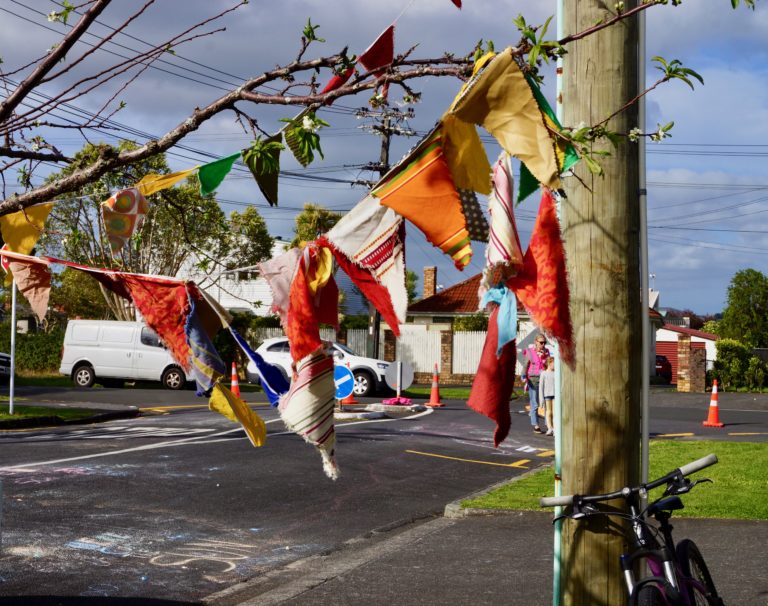
5. Invite the community
Talking to the neighbours was a priority, as closing a street for a whole day is a big ask. Luckily they were almost unanimously supportive, as the daily traffic chaos is no picnic for them, either.
We also reached out early to other local schools and local organisations, including Auckland Zoo, Pt Chev Library, the local Cycling Without Age chapter, Eco Matters and their cool bikes, a school parent with demonstration e-bikes, the Safe Kids campaign (to highlight driveway safety), and at the last minute, the Auckland Transport consultation team for the upcoming streetscape revamp.
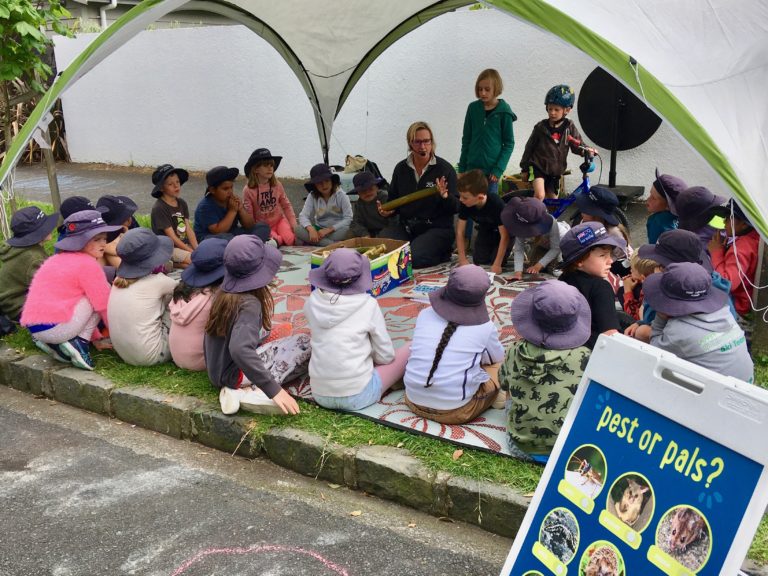
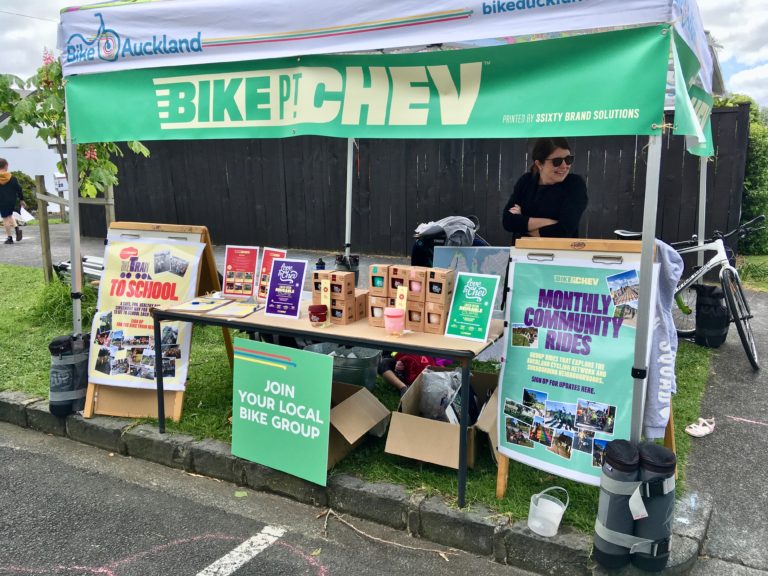
6. Rally your helpers
As the day approached, we summoned the troops: willing teachers and a couple of dozen parents whose job was to haul gear and set up and pack down, staff each end of the street in shifts, coordinate activities throughout the day, and even DJ during dinner.
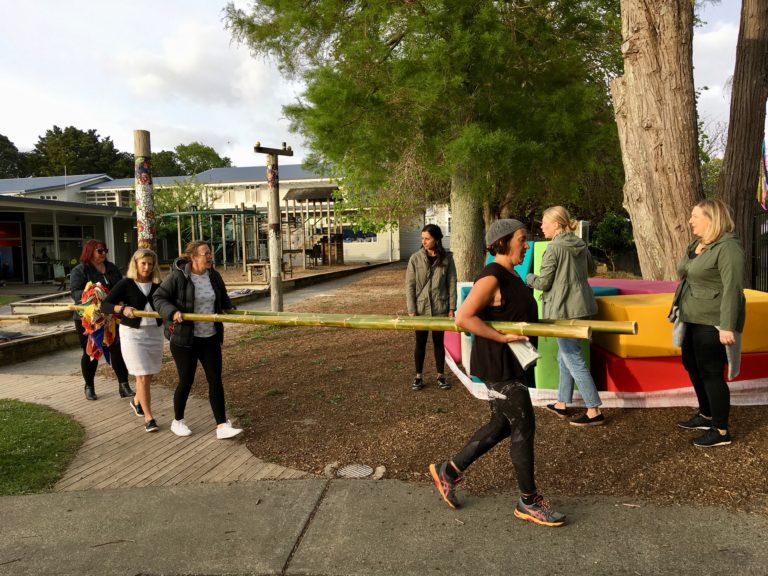
Right up to the last minute, donations and favours came pouring in. A local coffee business, Macgregor Brothers, offered free coffees (BYO cup) before school, and hot chocolates and brownies for kids at morning tea (for a gold coin donation to the City Mission), as well as a fully catered sit-down lunch for the teachers. One school family harvested and donated massive bamboo canes for making ‘bug hotels’. Another lent us their giant domino sets, and another arranged the arrival of colourful PlaceKit street furniture, while a local cafe loaned us gorgeous fabric bunting… it’s astonishing how generous people are!
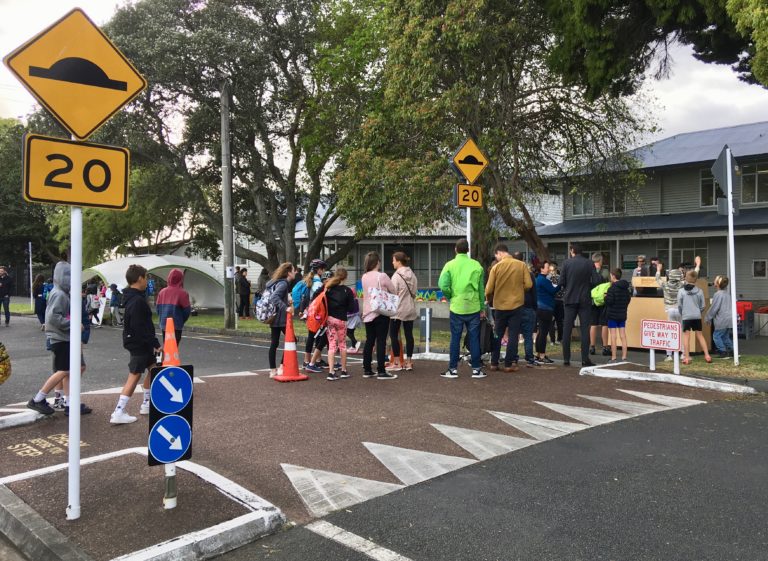
7. Set the scene
On the day itself, volunteers worked from first light to set the scene. Tall bamboo, strung with colourful bunting, framed each end of the street. A carpet of artificial turf created a ‘lawn’ mid-block. Racks and racks for bike parking stood ready. As the children began to arrive, at first they hugged the footpaths… and then, after the first few tentatively discovered the street was theirs for the taking, it was all on.
So, what do you do with a street, once you’ve won the use of it for the day? We’d put out the gear, to get things started: colourful Placekit modular street furniture, and all sorts of old-fashioned play materials ready to be discovered: stilts, elastics, skipping ropes, chalk, domino blocks. It was basic, inviting stuff, and the kids needed no invitation.
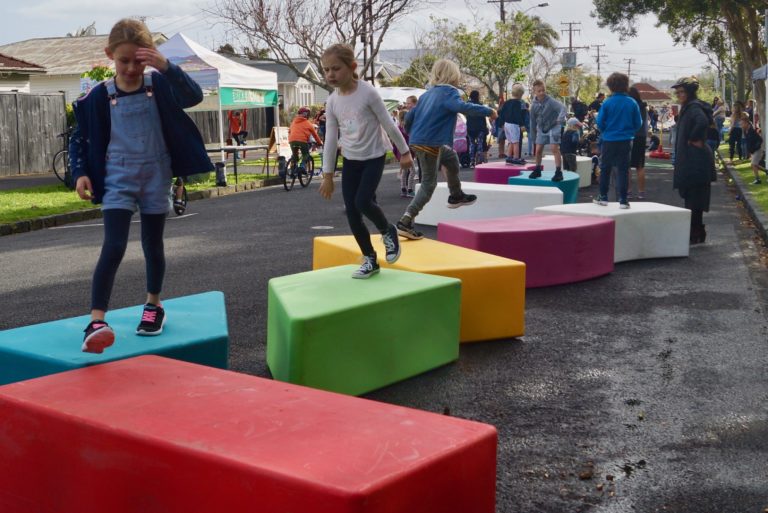
The school day formally began with a full assembly out on the street, singing waiata and songs (including ‘Here Comes The Sun’!). Keren had done a phenomenal job of encouraging the teachers to get creative and treat the street as learning and playing space all day long. There was art on the fence; fish-friendly stencils around the drains (designed by the art classes at Pasadena Intermediate), and visits from Auckland Zoo for environmental education, and the local library came along for storytime.
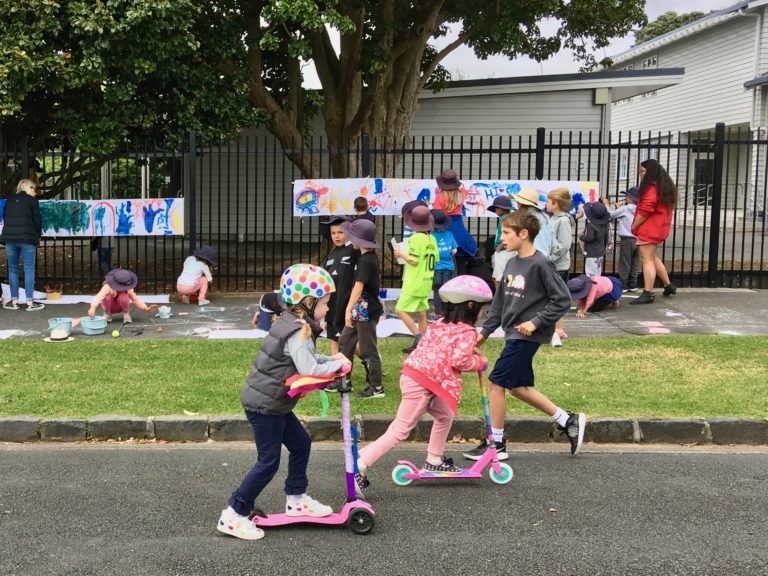
Above all, the school day was about sheer freedom and play. The children interacted with the materials on hand in fascinating ways. Placekit was constantly being moved into new configurations to create playgrounds and imaginary structures. Elastics and skipping ropes not just in the usual way, but also to define spaces and blocks to create rooms and games. The dominos became domino trails, structures for ball games, houses and beds for teddy bears. Street trees made the play space vertical as well as horizontal.
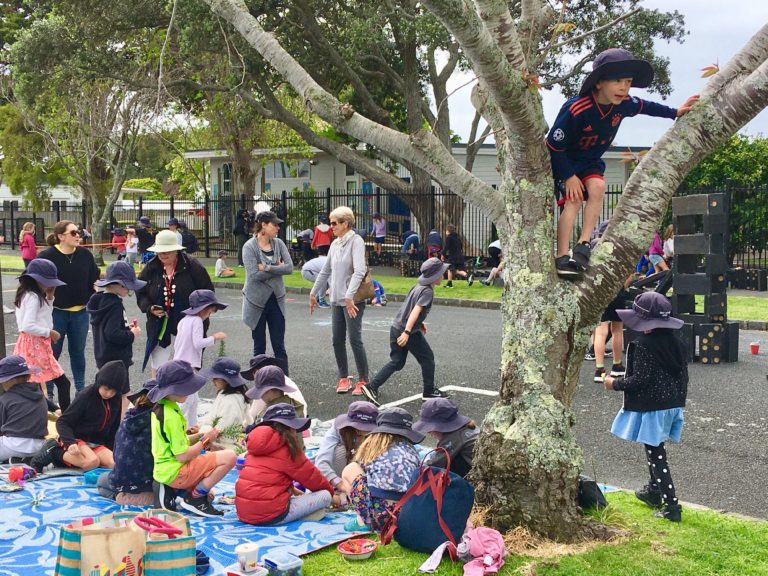
When parents and neighbours reappeared at the end of the school day, the creativity became intergenerational. Young and old played street games, hopscotch, stilts, quoits, teaching each other new rules. Cycling Without Age’s older chauffeurs gave bike rides to groups of giggling children. Multi-generational picnics took place on the artificial turf, and the grass berms became a front-row seat for a wild rumpus. It was rad.
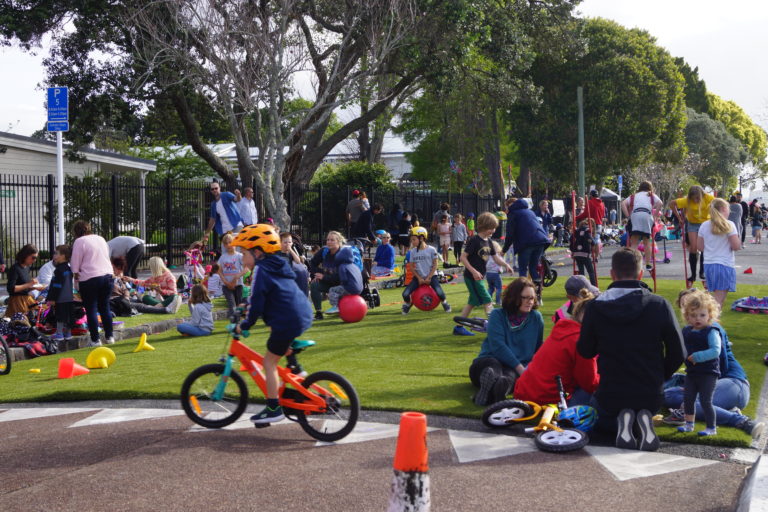
8. If you build it…
… they will come. We had encouraged people to leave the car at home and show up on foot, on bikes, on scooters, by bus. And they did! It was refreshing confirmation of the hunch that sometimes, all it takes is the invitation to do things differently. Having highly visible and secure bike parking at both ends of the street probably helped, too.
9. Debrief while it’s fresh
Thanks to the Innovating Streets team at NZTA and the experts from Mackie Research, we had an online survey all ready to go after the event, which we sent to the community at large, street residents, and our volunteers. We’re still working through the answers, but some key themes, aside from an enthusiastic “let’s do it again!”: people loved arriving at the event under their own steam, and didn’t find it hard to leave the car at home. The food trucks were popular as a no-prep dinner option, but equally people would have enjoyed an old-fashioned sausage sizzle.
Everyone loved the multi-generational aspect of the event, with parents, grandparents, kids and neighbours of all ages teaching each other games (hopscotch, stilts, elastics, you name it) and sharing the street. And there was support for a dedicated bike-and-scoot zone at future events – so kids could wheel around as much as they liked.
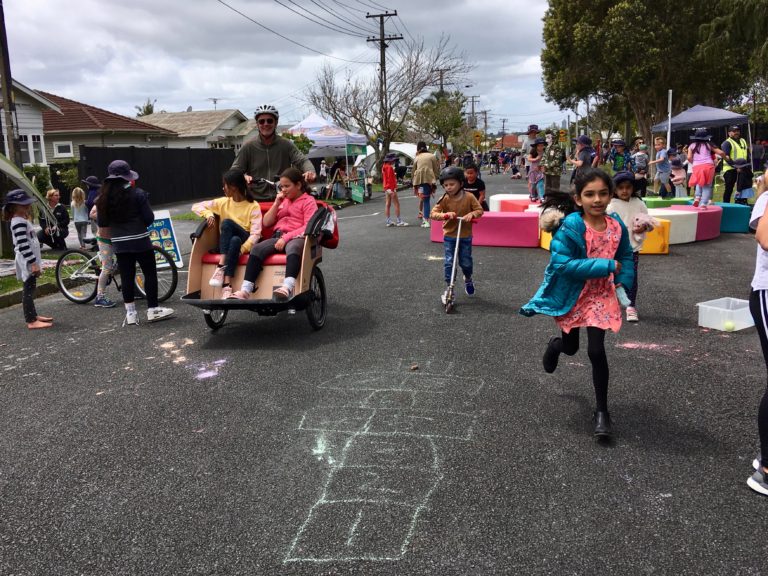
10. Plan your next step
One of the main responses, especially from the kids on the day itself, was: ‘When are we doing this again?’ We’re also hearing hopes it’ll now be an annual event. Nothing succeeds like success, even though it was a massive effort for our small team!
Meanwhile, we’re thinking about some options, and the potential to play with the idea of play streets. Could we pull off a full-day event on a more modest scale and budget, purely with volunteers? What elements of the day could we or other schools or communities try as mini-play streets? Would a weekly traffic-free morning or afternoon be doable, with or without free coffees for parents? Or could we close the street for a few hours after school?
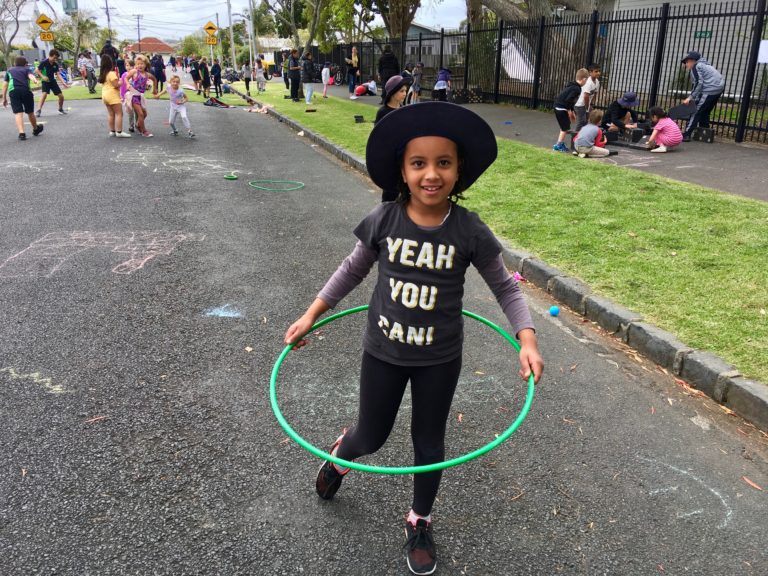
Could a school run a low-key DIY play street culminating in a family picnic on, say, the first Friday of every month? Could you set up a calendar of planned street closures, and just… make it happen? What if all you needed was a few wheelie-bins or pink traffic cones at each end of the street, some notes in letterboxes a few days ahead, and some signs on poles? Could it be that simple? (The Innovating Streets for People project is the space to watch here!)
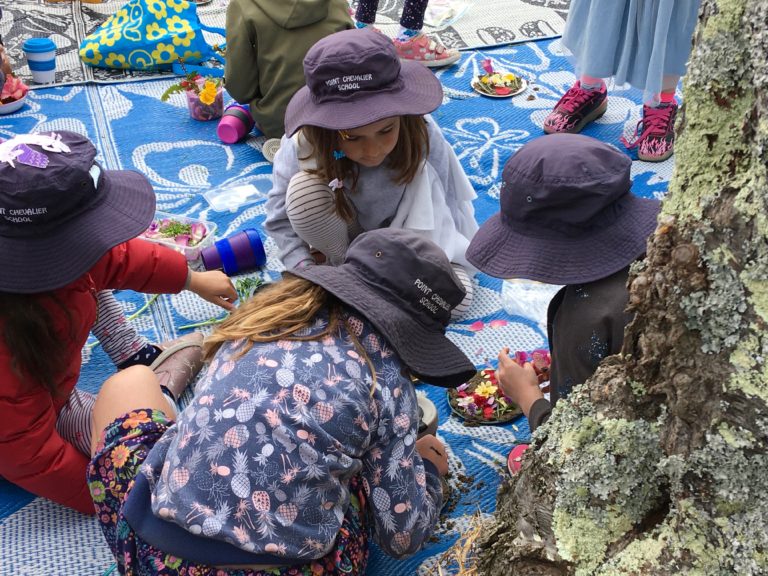
And one last thing: share the love!
We took heaps of photos, which you can see here. It was also a real treat to also be visited by the KEA Kids News crew on the day, who made this lovely report (starts halfway through the video bulletin).
And we always planned to make a ‘StreetFilms’ style mini-documentary about our event, and here it is!
We’re happy to share the story, because the more of this sort of thing we see, the more we can try. In fact, it feels like the beginning of a movement. Let’s give it a push!
https://twitter.com/nzdodo/status/1190052396765892608?s=20

